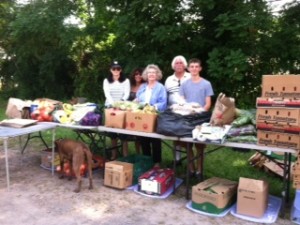Do you shop at a Pantry? Do you work at a Pantry? Do you donate to a Pantry? – Part 3
THIS SOUP HAS NOTHING IN IT BUT SALT.
At first, when I was just learning to be a pantry coordinator, I didn’t understand what was wrong. We got in some soup which everyone looked at, read the label, and left on the shelf. So, I asked Barry to visit the pantry.
“WHAT’S THE DEAL WITH THIS SOUP? Most of the people are leaving it on the shelf. There’s only 6 different things they can take home here. Why are they leaving the soup behind?”
“Well, it’s the nutritional content” he said, reading the label. There’s no nutrition. And, everyone knows too much salt is not good.”
I began to watch the shoppers reading the labels and I asked questions. I got an earful of important information from people trying to live on pantry food. I learned several important things:
THOSE SHOPPING IN A PANTRY HAVE LITTLE OR NO MONEY FOR HEALTH CARE/MEDICAL EXPENSES. FOOD IS THE FRONT LINE OF DEFENSE FOR THOSE ON A LIMITED BUDGET. The pantry food is, sometimes, nutritionally inadequate because
there may not always be enough of it
there may not be enough fresh vegetables
everything is canned resulting in high sodium products
there is no real choice.
At the time, there were fewer than 10 items in the pantry to choose from which didn’t offer a shopper enough options to deal with dietary restrictions (celiac disease, hypertension, diabetes), personal preference, and enough variety to offer good nutritional selection.
As a new coordinator, I still didn’t yet know all my options and wasn’t comfortable with the Food Bank system yet. This much I knew:
The food supply I had to choose from was then and is now supply driven instead of need driven. In other words, I can’t order everything the pantry needs at a given time because it’s not always available. Foods available at the Food Bank are donations from grocery stores, farms, food manufacturers.
MUCH FOOD BANK FOOD IS DIVERTED FROM A LANDFILL. In other words, it’s salvage. I order food donated from test marketing disasters, crop overproduction, Food Bank food drives.
MOST FOOD COMING INTO OUR PANTRY ARE NUTRITIONALLY SOUND BECAUSE I WON’T ORDER IT IF IT ISN’T. There are some issues with sodium and fat…but not many.
Several things happened in those early years that I coordinated the pantry. They really helped:
The HPNAP people took a stand against too much salt which I got all excited about. They issued guidelines forbidding agencies to use HPNAP funds to purchase foods have too many grams of salt per serving.
Gradually, as the economy declined, the HPNAP people added other nutritional improvements:
1% milk
Whole grain breads
Lean meats
A minimum 3 -day-supply of food for everyone in the household.
Fresh produce.
THESE GUIDELINES COMPLETELY CHANGED HOW THE PANTRY OPERATED AND WHAT WAS AVAILABLE. IT WAS GLORIOUS!
The pantry offered very little junk food even though there was certainly a lot of it at the Food Bank. The Food Bank accepts donations but that doesn’t mean I have to put the junk food on my pantry’s shelf.
These guidelines and availability are still a reality in the pantry world as our calendar approaches 2015. I leave the junk food off my orders so other coordinators can have it.
And, I’m still grateful for:
crop overproduction
Food Bank food drives
HPNAP guidelines
food that can be diverted from the landfill
generous bakeries
the Farm Stand
the Food Bank truck that’s making the rounds of the grocery stores, farms, food manufacturers so we can have their overage at our food pantry.
Peace and food for all.
Thank you for reading this blog/book.
Please refer this article to your preferred social media network.
Please send a comment.
Don’t forget to join the email list.
Thurman Greco








